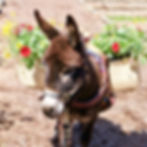Training Donkeys is Different than Training Horses
- Kim Milikowski
- Apr 13, 2020
- 4 min read
Updated: Mar 10, 2021

Coming from a life with horses I quickly realized that donkeys learn and interact with humans much differently than a horse does. I don't know how many times I have been asked if donkeys are as stubborn people say they are. No, they are not. They gather and process information and are not as reactive as a horse. Sometimes this might appear to an onlooker as a stubborn donkey.
The relationship that is built with the donkey starts in the barn and in the pasture as you interact with them. This is long before you ever put a halter on them. I believe that the donkey-human bond is more like that of dog-human relationship. They are curious and playful. When we go out to the pasture to clean or fix a fence the donkeys are right there tugging on your jacket or standing nearby. They crave attention from people. If you take the time to reinforce this bond with them and they begin to trust you, you will be able to lead your donkey through any obstacle.
The Donkey Minute
Horses can often be easily convinced to make a movement with pressure. They move away from pressure. Perhaps this is because of their flight mentality when a threat is present. Nature provided the horse with long legs and the ability to run quickly from threats. His cousin the donkey was not blessed with long legs but rather short legs with a more vertical pastern angle making for a slow gait. When the donkey perceives a threat he will assess the situation, often freezing in his tracks. This is the behavior that is sometimes misunderstood as being stubborn. They need a 'Donkey Minute' to analyze the situation whereas a horse would spin around and run away in a second.
We took a group of our donkeys to a large equine event this past fall. Horses were zipping around everywhere. We have miniature donkeys so they walk much slower than a full size horse. Their little legs just can't keep up. We could sense the horse people becoming impatient with the donkeys, wanting to rush them. A few donkeys were young and they were unsure about stepping on rubber mats in aisles. Numerous well meaning horse people came up wanting to push them onto the mat. The donkey just needed to have a minute to process. If they trust the handler they will follow you just about anywhere. We walk our donkeys through our greenhouses, garden shop, over black weed barrier and onto our porch. Do they go over everything immediately? No. But once they trust you enough to go over something scary they build a bond with you and it becomes easier with each new situation you present to them..

We have a concrete floor in the center aisle of our barn. At each end there are sliding doors that move on a metal track at the bottom. It isn't large but for some reason any new donkey we get needs to be convinced it is ok to walk over it. Our little gelding Boomer was one of the worst cases of track fear we have encountered. I like to walk confidently forward while leading the donkey to build their confidence. I find that when you get out in front of the donkey and look back at them they become suspect of the situation. For any of you who train dogs the same applies. Walk with purpose, confidently while walking your dog. He will respond to this, walking confidently beside you. A meek handler will put the dog on high alert and he will be cautious and reactive.

My donkey training buddy, Stacey, and I decided to train Boomer on trail obstacles one day. We set up everything in a field. Boomer was in a stall so he came into the aisle no problem. When we tried to lead him from the barn he planted and would not budge. Stacey used her sweetest voice moving back near his withers and reassuring him the track was fine. We put a soft pressure on the lead. As the donkey made any movement forward we exaggerate the release on the pressure and then repeated. This is also how we teach them to lead without any obstacle.
We are not pulling them. This is very subtle. Stacey finally got Boomer over the track 30 minutes later (Boomer needed the Donkey 30 Minute:-)) It generally is a much quicker process. We will give them a treat to reward as well. Once Boomer went over the track he went over with very little coaxing and now walks freely over it.
If you have ever had a horse with issues picking up feet you know that you can work so hard to get one front foot up. They finally seem like they are settling down and you go to the other front foot and it is like he never picked up a foot in his life. A donkey remembers from side to side. They process information. Teach them how to pick up one front foot and they are fine with the other front foot.
It is rare that we ever punish a donkey. They never forget and you can set yourself back weeks if you are harsh with them. They actually respond to a firm 'NO'! If they nibble a little too much we just pinch their upper lip and say NO! They learn very quickly.

A donkey's lack of flight reaction makes them trustworthy and calm trail mounts. They are wonderful driving prospects, quickly learning voice commands and are generally well mannered and quiet while under harness. Pictured at the right is Stacey and Paris. The donkey is so intelligent he can often times outsmart his handler so you need to pay close attention.
